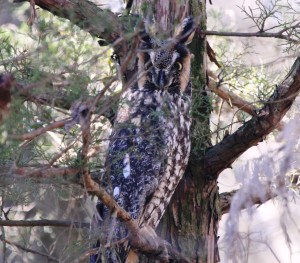A Rare Glimpse of the Seclusive Long-eared Owl

Brian Johnson, a member of our land stewardship staff, considers himself very lucky to have spotted this Long-eared Owl (Asio otus) at one of our New Jersey preserves. Brian said that Long-eared Owls are extremely secretive, and will often take off at the sight of a human, even if that person is far away. Long-eared Owls are less common than Great Horned Owls (Bubo virginianus) and when found are usually in dense evergreen forests.
Brian was able to take this shot from 75 feet away, using a Canon Digital SLR camera with a 400 mm lens. Brian lucked out not only because the owl didn’t fly away once he was in sight, but also because the owl had chosen an unusually low perch in an evergreen tree. They are usually much higher up, making them nearly impossible to spot through layers of branches.
How to tell a Long-eared Owl from a Great Horned Owl? Brian says both species have prominent ears, but the Long-eared Owl’s ear tufts are closer together, and more centered on the top of its head, while a Great Horned Owl’s ears are more to the side, “like a cat’s ears.” Great Horned Owls are also chunkier than the long and lean Long-eared Owl, as seen in Brian’s photo. Brian says the owl stretched itself out when it saw him, assuming what is known as a “camouflage posture.” However, it remained in the tree because Brian did not try to approach it too closely.
According to Brian, during some years, a fair number of Long-eared Owl winter in southern New Jersey, sight-unseen. Trees that the owls choose to roost in are often “white-washed” with owl droppings and the ground littered with owl pellets, but, Brian says, by the time you come across such a tree it is almost certain that the owl has left the tree.
Our preserve stewardship staff has observed a fluctuation in owl populations from year to year; it depends on the population of the owls’ prey: mostly meadow voles and rice rats in the tidal brackish areas. During the clean-up process on our New Jersey preserves after Hurricane Sandy (which is still on-going—see other recent posts by our management staff), Brian helped to clear preserve trails of “wrack”: uprooted or dead grasses and other debris carried by water and deposited on the trails. The wrack was full of hundreds of dead rodents that had drowned in the storm waters.
Since Hurricane Sandy, meadow vole and rice rat populations have been relatively low, and are likely to remain low until their usual breeding seasons this spring and summer. Since the New Jersey salt marsh rodents’ populations took such a hit this past fall, Brian says it is likely the owls that usually depend on them for prey may be moving further inland in search of food.
Brian recommends if you do find an owl, don’t approach too closely and crouch down making yourself less threatening. Try not to disturb the owl by returning frequently, and don’t tell anybody where you have found the owl! This way you may be able to enjoy owls roosting in the same spot year after year. If disturbed too frequently owls often abandon a roost site, and may never return again.
